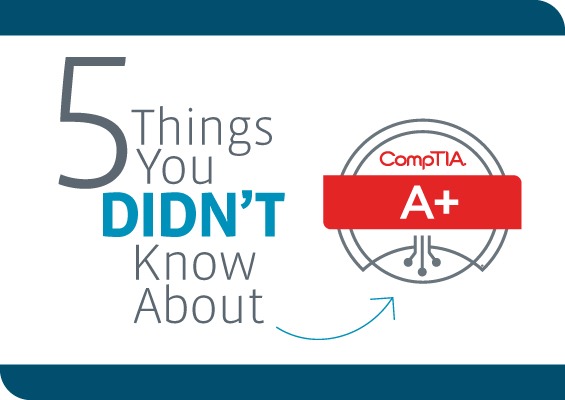 In December 2015, we released the latest version of CompTIA A+. The 900 series expands its coverage of new and diverse technologies to reflect today’s organizational IT environment. If you took an earlier version of CompTIA A+ or have heard about it from people who did, you may be surprised to learn everything that it now covers. Here are five things you may not know about CompTIA A+ that help IT pros gain a foundational knowledge to launch their careers.
In December 2015, we released the latest version of CompTIA A+. The 900 series expands its coverage of new and diverse technologies to reflect today’s organizational IT environment. If you took an earlier version of CompTIA A+ or have heard about it from people who did, you may be surprised to learn everything that it now covers. Here are five things you may not know about CompTIA A+ that help IT pros gain a foundational knowledge to launch their careers.
-
It’s not just about Windows and PCs. While previous versions of the A+ certification exams focused on supporting Windows-based desktops and laptops, the current version reflects a major shift in the IT support role. Instead of a PC break-fix model driving required skills, the 900 series focuses on supporting a user’s ability to access needed information, no matter the device. This shift in support philosophy means that IT pros must be familiar with multiple operating systems.
So, in addition to various flavors of Windows, CompTIA A+ now includes knowledge and skills related to Apple OS X, Linux, iOS, Android and Windows Mobile. Wearables, tablets and smartphones are covered alongside the ubiquitous PC. And, managing mobile devices – the hardware, the data and the connections – is an increased point of emphasis.
-
IT support and troubleshooting sit at the core of the certification. Technical support and troubleshooting are among the top three skills requested in job ads for entry-level IT professionals. And with good reason. It’s one thing to understand how something works, but it’s quite another to be able to troubleshoot when something goes awry.
Previous versions of the CompTIA A+ certification included troubleshooting, but the 900 series places special emphasis on the ability to solve problems. The domains of each of the two exams build up to the troubleshooting domain. Not only do certification candidates have to install and configure, they have to identify the source of any problems and resolve them – regardless of whether the problem is related to the device, the data connection or the application.
-
Cybersecurity is a big deal. Once believed to be the domain of the IT security specialist, there’s growing awareness that IT security is a responsibility shared by all – from the end user in accounting to the CEO. IT professionals, especially those in help desk and technical support roles, carry the burden of being at the front lines in the battle against unauthorized intrusions.
The new CompTIA A+ recognizes the critical role tech support plays in protecting an organization’s digital assets. In fact, eight of the nine certification domains have an objective or sub-objective related to security, privacy or risk mitigation. As the attack surface of a typical organization has increased, so have both the depth and breadth of knowledge required in the technical support job role. CompTIA A+ reflects this reality.
-
Cloud and virtualization are in the mix. Gone are the days when most organizations were simply experimenting with cloud computing. As companies rely more heavily on cloud-based technologies to run mission-critical IT systems, the need to support those systems becomes paramount. CompTIA A+ introduces the basics of virtualization, cloud computing and desktop imaging, and deployment – knowledge needed to support today’s IT infrastructures.
By introducing core infrastructure concepts, the CompTIA A+ certification also establishes a foundation on which to build more advanced expertise. It opens the door to further study in areas such as tiered endpoint support, physical server maintenance, virtual system administration, network configuration and storage planning – all core skill sets in IT systems operations.
-
It sets the stage for IoT support. According to Gartner, 25 billion connected devices will be in use by 2020. These include everything from home automation systems and autonomous vehicles to children’s toys and home refrigerators. What happens when users can’t connect these devices to their networks? Who will they contact?
In the same way that A+ lays the foundation for building infrastructure skills, it also establishes the baseline knowledge needed to support the Internet of Things (IoT). Connected devices rely on a number of layered technologies, including the device itself (both its hardware and software), a network, an Internet connection, backend cloud services and a user interface. With its coverage of different device form factors (think smartphones, tablets, wearables), numerous operating systems, networking fundamentals and troubleshooting, and cloud computing basics, A+ lays the groundwork for building IoT capabilities.
Ready to get CompTIA A+ certified? Download the exam objectives and start prepping today.

